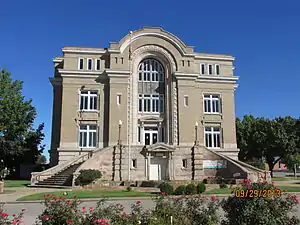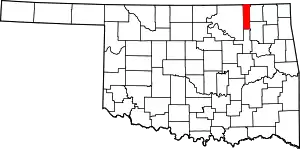Washington County, Oklahoma
Washington County is a county located in the northeastern part of the U.S. state of Oklahoma. As of the 2010 census, the population was 50,976.[1] Its county seat is Bartlesville.[2] Named for President George Washington, it is the second smallest county in Oklahoma in total area,[3] adjacent to the largest county in Oklahoma, Osage County.
Washington County | |
|---|---|
 | |
 Location within the U.S. state of Oklahoma | |
 Oklahoma's location within the U.S. | |
| Coordinates: 36°44′50″N 95°58′50″W | |
| Country | |
| State | |
| Founded | 1907 |
| Named for | George Washington |
| Seat | Bartlesville |
| Largest city | Bartlesville |
| Area | |
| • Total | 424 sq mi (1,100 km2) |
| • Land | 415 sq mi (1,070 km2) |
| • Water | 8.8 sq mi (23 km2) 2.1%% |
| Population (2010) | |
| • Total | 50,976 |
| • Estimate (2019) | 51,527 |
| • Density | 123/sq mi (47/km2) |
| Congressional district | 1st |
| Website | www |
Washington County comprises the Bartlesville, OK Micropolitan Statistical Area, which is also included in the Tulsa-Muskogee-Bartlesville, OK Combined Statistical Area. It is located along the border with Kansas.
History
The Osage ceded their land claims in 1825, and the Federal Government allowed the Western Cherokee to settle in this area in 1828. The 1835 Treaty of New Echota confirmed Cherokee ownership of the land. The area now covered by Washington County was part of the Cherokee Saline District between 1840 and 1856 and the Cooweescoowee District from 1856 to 1906.[3]
The first post office was established in 1859 at the confluence of Butler Creek and the Caney River by James L. Butler. Known as Little Verdigris, the settlement also had a trading post and a school. The Civil War caused most of the inhabitants to move away and the post office closed in 1866. In 1867, the Cherokees sold 157,600 acres to the Eastern Delaware [3]
In 1870, Nelson Carr built a grist mill along the Caney River, which he used to grind seed corn. In 1875, he sold the mill to Jacob Bartles (for whom the town of Bartlesville would be named), who modified the mill to produce wheat flour. Other important agricultural crops included potatoes, sorghum and oats, as well as prairie hay and pecans. Cotton production was attempted in the early 1900s, but the soil proved unsuitable and this crop was soon discontinued.[3]
The first commercial oil well in Oklahoma, designated as Nellie Johnstone Number One, was drilled near Bartlesville in 1897. According to the Encyclopedia of Oklahoma History and Culture, the industry developed slowly because of communal land ownership by the Cherokees, the lack of crude oil markets, and lack of reliable transportation. Bartlesville became an oil boom town only after 1900, when the nearby Osage County oil fields were developed and railroads were built into the area. In 1900, Phoenix Oil Company built a pipeline from Osage County to Bartlesville's Atchison, Topeka and Santa Fe Railway depot, where there was an oil loading facility. Oil was shipped from there to a refinery in Neodesha, Kansas in the same year. Washington County fields were developed soon afterward. The Bartlesville Field reached peak development during 1904 to 1906; the Bartlesville-Dewey Field in 1905 and the Copan, Canary, Hogshooter, and Wann fields were located in 1907. Several oil companies set up headquarters in the county, most notably Phillips Petroleum in Bartlesville.[3]
Railroads came to this area at the turn of the 20th Century. The Atchison, Topeka and Santa Fe Railway opened a line from Owen to Owasso, Oklahoma in 1899. The Missouri, Kansas and Texas Railroad opened a line from Stevens, Kansas to Dewey, Oklahoma in 1901-2 and another line from Hominy, Oklahoma to Bartlesville in 1903–04.[3]
Geography
According to the U.S. Census Bureau, the county has a total area of 424 square miles (1,100 km2), of which 415 square miles (1,070 km2) is land and 8.8 square miles (23 km2) (2.1%) is water.[4] It is the second-smallest county in Oklahoma by land area and smallest by total area. It lies in the Eastern Lowlands physiographic region, and is drained by the Caney River. Lakes and reservoirs include Copan Lake, Silver Lake and Bar-Dew Lake.[3]
Adjacent counties
- Montgomery County, Kansas (north)
- Nowata County (east)
- Rogers County (southeast)
- Tulsa County (south)
- Osage County (west)
- Chautauqua County, Kansas (northwest)
Demographics
| Historical population | |||
|---|---|---|---|
| Census | Pop. | %± | |
| 1910 | 17,484 | — | |
| 1920 | 27,002 | 54.4% | |
| 1930 | 27,777 | 2.9% | |
| 1940 | 30,559 | 10.0% | |
| 1950 | 32,880 | 7.6% | |
| 1960 | 42,347 | 28.8% | |
| 1970 | 42,277 | −0.2% | |
| 1980 | 48,113 | 13.8% | |
| 1990 | 48,066 | −0.1% | |
| 2000 | 48,996 | 1.9% | |
| 2010 | 50,976 | 4.0% | |
| 2019 (est.) | 51,527 | [5] | 1.1% |
| U.S. Decennial Census[6] 1790-1960[7] 1900-1990[8] 1990-2000[9] 2010-2019[1] | |||
As of the 2010 United States Census, there were 50,976 people, 21,036 households, and 14,123 families residing in the county. The population density was 45/km2 (118/mi2). There were 23,451 housing units at an average density of 55.3 per square mile (21.4/km2). The racial makeup of the county was 93.9% white, 2.4% black or African American, 10.3% Native American, 1.1% Asian, less than 0.1% Pacific Islander, 1.7% from other races, and 6.1% from two or more races. Five percent of the population were Hispanic or Latino of any race.
There were 21,036 households, out of which 30.1% had children under the age of 18 living with them, 52.1% were married couples living together, 11% had a female householder with no husband present, 4% had a male householder with no husband present, and 32.9% were non-families. Individuals living alone accounted for 28.7% of households and individuals who were 65 years of age or older living alone accounted for 12.9%. The average household size was 2.39 and the average family size was 2.91.
In the county, the population was spread out, with 23.4% under the age of 18, 8.1% from 18 to 24, 22.8% from 25 to 44, 27.9% from 45 to 64, and 17.8% who were 65 years of age or older. The median age was 41.4 years. For every 100 females, there were 93.7 males. For every 100 females age 18 and over, there were 109.8 males.
The median income for a household in the county was $35,816, and the median income for a family was $43,514. Males had a median income of $34,201 versus $22,389 for females. The per capita income for the county was $20,250. About 8.70% of families and 11.90% of the population were below the poverty line, including 15.70% of those under age 18 and 7.80% of those age 65 or over.
Politics
| Voter Registration and Party Enrollment as of January 15, 2019[10] | |||||
|---|---|---|---|---|---|
| Party | Number of Voters | Percentage | |||
| Democratic | 7,582 | 23.71% | |||
| Republican | 18,872 | 59.02% | |||
| Others | 5,519 | 17.26% | |||
| Total | 31,973 | 100% | |||
| Year | Republican | Democratic | Third parties |
|---|---|---|---|
| 2016 | 71.2% 15,825 | 22.7% 5,048 | 6.1% 1,351 |
| 2012 | 73.9% 15,668 | 26.1% 5,532 | |
| 2008 | 72.3% 16,457 | 27.7% 6,308 | |
| 2004 | 70.7% 16,551 | 29.3% 6,862 | |
| 2000 | 66.5% 13,788 | 32.0% 6,644 | 1.5% 312 |
| 1996 | 56.1% 11,605 | 32.5% 6,732 | 11.4% 2,357 |
| 1992 | 47.9% 11,342 | 27.9% 6,593 | 24.2% 5,728 |
| 1988 | 67.3% 14,613 | 32.1% 6,971 | 0.6% 129 |
| 1984 | 77.2% 19,043 | 22.2% 5,476 | 0.6% 148 |
| 1980 | 70.5% 16,563 | 24.9% 5,854 | 4.6% 1,086 |
| 1976 | 67.2% 14,560 | 31.8% 6,898 | 1.0% 212 |
| 1972 | 79.7% 16,347 | 17.8% 3,658 | 2.4% 495 |
| 1968 | 62.4% 12,812 | 22.6% 4,641 | 15.1% 3,091 |
| 1964 | 59.1% 12,382 | 40.9% 8,571 | |
| 1960 | 71.4% 13,700 | 28.6% 5,479 | |
| 1956 | 69.3% 12,488 | 30.7% 5,529 | |
| 1952 | 64.5% 11,334 | 35.5% 6,238 | |
| 1948 | 52.3% 6,036 | 47.7% 5,508 | |
| 1944 | 56.1% 6,533 | 43.7% 5,090 | 0.2% 18 |
| 1940 | 53.7% 7,347 | 46.0% 6,289 | 0.3% 40 |
| 1936 | 45.5% 5,201 | 54.3% 6,202 | 0.2% 26 |
| 1932 | 40.7% 4,713 | 59.3% 6,863 | |
| 1928 | 73.5% 7,258 | 26.0% 2,563 | 0.6% 56 |
| 1924 | 55.2% 4,579 | 42.0% 3,487 | 2.8% 234 |
| 1920 | 57.8% 4,105 | 39.5% 2,805 | 2.7% 189 |
| 1916 | 44.0% 1,727 | 46.9% 1,839 | 9.2% 359 |
| 1912 | 43.6% 1,477 | 46.1% 1,561 | 10.3% 347 |
NRHP sites
The following sites in Washington County are listed on the National Register of Historic Places
- Bartlesville Downtown Historic District, Bartlesville
- Bartlesville Civic Center, Bartlesville
- Dewey Hotel, Dewey
- LaQuinta, Bartlesville
- Nellie Johnstone No. 1, Bartlesville
- Old Washington County Courthouse, Bartlesville
- Frank and Jane Phillips House, Bartlesville[12]
- Price Tower, Bartlesville
References
- "State & County QuickFacts". United States Census Bureau. Retrieved November 13, 2013.
- "Find a County". National Association of Counties. Retrieved June 7, 2011.
- Jon D. May, "Washington County." Encyclopedia of Oklahoma History and Culture.
- "2010 Census Gazetteer Files". United States Census Bureau. August 22, 2012. Retrieved February 22, 2015.
- "County Population Totals: 2010-2019". Retrieved November 11, 2020.
- "U.S. Decennial Census". United States Census Bureau. Retrieved February 22, 2015.
- "Historical Census Browser". University of Virginia Library. Retrieved February 22, 2015.
- Forstall, Richard L., ed. (March 27, 1995). "Population of Counties by Decennial Census: 1900 to 1990". United States Census Bureau. Retrieved February 22, 2015.
- "Census 2000 PHC-T-4. Ranking Tables for Counties: 1990 and 2000" (PDF). United States Census Bureau. April 2, 2001. Retrieved February 22, 2015.
- "Oklahoma Registration Statistics by County" (PDF). OK.gov. January 15, 2019. Retrieved February 27, 2019.
- Leip, David. "Dave Leip's Atlas of U.S. Presidential Elections". uselectionatlas.org. Retrieved March 30, 2018.
- "Oklahoma National Register". nr2_shpo.okstate.edu. Retrieved 26 April 2018.
External links
| Wikimedia Commons has media related to Washington County, Oklahoma. |

